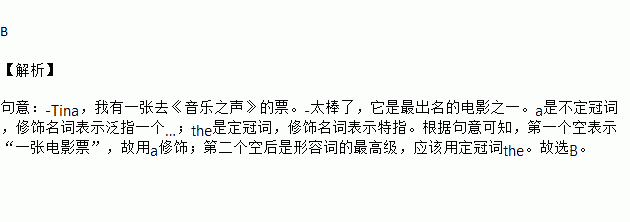题目内容
—Tina, I've got__ ticket to The Sound of Music.
—Great! It s one of most famous movies.
A. the: the B. a; the C. the: a
任务型阅读
Starting a book club is easy--- all you need is to love reading. Here’s how to get yours off to a flying start.
When you set up your club, the first thing is to get members for your club. They could be friends, family or those you know through kinds of activities, but they should all love to read. A small group of seven to ten people is usually an ideal size for a book club. Too many people make the discussions difficult.
Once you have a group, agree on how often you want to meet-----usually club members meet monthly. Pick a date and stick with it. That way, members can plan for it. Send out emails a week before the meeting to remind(提醒) them of the meeting time. Set meeting time length. An hour is a good start. Two hours usually does the trick.
Then, you need a good place. Libraries, parks and restaurants--- all the public(公共的) places make good meeting places. For many clubs, meeting at home works best because you don’t have to get dressed up, and homes are quiet. If members bring a plate of food or a bottle, it can help start conversation(谈话)
Please don’t forget the most important thing--- the book! Think about the books your club will enjoy. Your club can decide on books in different ways. Anyway, make sure to keep it light and fun.
After you decide all this, your book club is ready. Now, it’s time to hold the first meeting. Enjoy your reading.
How to 1. a club | ||
2.members | ●You can choose those people who 3. to read. ●Ideal4. for a book club: Seven to ten people are enough for discussions. | |
Setting the time | ●Set a 5. time. Send everyone an email to remind them of the6. meeting . ●Decide on how long the meeting will be. | |
Deciding7. to meet | ●You can meet in 8. places, like libraries, parks, and restaurants. ●For many clubs, meeting at home works9.. | |
Choosing the books | ●Think about the books your club will enjoy. ●Decide on the 10. of choosing books. |
There is a popular belief that goldfish only have a three-second memory. But a 15-year-old schoolboy from Adelaide has just finished an experiment(实验)to tell us that it is not true. He shows everybody that the goldfish is smarter than we think.
“I don’t believe that they had a three-second memory because animals need their memory, so they build up over time a knowledge of where the food is,” said Roy Stokes, a student at the Australian Science and Mathematics School.
He did the experiment in small tank(鱼缸)of goldfish. “I decided to get a bit of red Logo and just feed them next to that. Every day I’d put it in and spread food around it.” He said.
“At first they were a bit scared of it, but by the end of the three weeks, they were actually almost coming before I put the food in.”
After leaving the fish alone for a week, Rory placed the red Logo block in the tank again.
“They remembered perfectly well,” he said.
“They actually had a time faster than the average of the three feeds before I left.”
The goldfish showed that not only could they store information, they also had the ability to get it back as a later date.
Culum Brown, a research fellow at Sydney’s Macquarie University, has studied fish behavior for more than ten years.
He says his studies of Australian native fish show fish were intelligent creatures that know how to avoid enemies and catch food like any other animal.
“The thing that I really liked about Rory’s experiment is he not only got that classical conditioning going but the fact that he could get them next just to that specific coloured market. I thought it was really good.” He said.
1.Rory began his research by ______.
A. discussing with his classmates B. making friends with goldfish
C. asking his teacher for advice D. questioning a popular belief
2.Rory put a red Logo in the tank to ______.
A. connect food with the color B. make the tank nicer to look at
C. feed the fish at the same place D. give the fish something to play with
3.What’s the right order of Rory’s experiment?
a. find a tank of goldfish | d. take out the Logo |
A. adbecf B aebdcf C. dabefc D. adebcf
4.What do the last three paragraphs tell us?
A. Rory’s research was highly praised by experienced experts.
B. Rory’s experiment failed to meet the scientific standard.
C. Many scientists had already done the experiment before.
D. Fish are the cleverest animal in Australia.
5.What can we learn from the story?
A. Fish can become smarter with the help of red color.
B. What everybody believes is not necessarily true.
C. Scientists should learn from middle school students.
D. Young people are generally smarter than aged ones.

